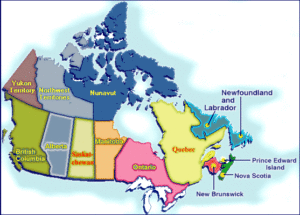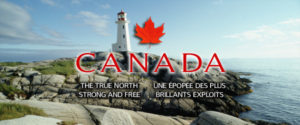
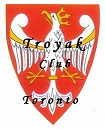
HAPPY CANADA’S 153rd BIRTHDAY !
BONNE FÊTE DU CANADA !
![]()
CANADA
www.canada.ca
https://en.wikipedia.org/wiki/Canada
Canada is a country in the northern part of North America. Its ten provinces and three territories extend from the Atlantic to the Pacific and northward into the Arctic Ocean, covering 9.98 million square kilometres (3.85 million square miles), making it the world’s second-largest country by total area. Its southern border with the United States, stretching 8,891 kilometres (5,525 mi), is the world’s longest bi-national land border. Canada’s capital is Ottawa, and its three largest metropolitan areas are Toronto, Montreal, and Vancouver. Official languages: English and French. Population: 38 millions. Monetary Unit: Canadian Dollar. Nunavut is the newest, largest, and most northerly territory of Canada. It was separated officially from the Northwest Territories on April 1, 1999. Capital : Iqaluit.


TROYAK EXECUTIVE TEAM is informing all members, colleagues, collectors, and Polonia at large, that Club meetings taking place at John Paul II Polish Cultural Centre, 4300 Cawthra Rd. (just south of Hwy. 403), Mississauga, Ontario. The new members are always welcome. www.polishculturalcentre.ca
ADRES SPOTKAÑ KLUBOWYCH ! Zarząd Główny Klubu “Troyak” informuje wszystkich członków kolekcjonerów, sympatyków oraz całą Polonię, że spotkania klubowe odbywają się w Polskim Centrum Kultury im. Jana Pawła II, przy 4300 Cawthra Rd. (na południe od autostrady 403), Mississauga, Ontario. Zapraszamy nowych członków do prężnego. Klubu “Troyak”. www.polishculturalcentre.ca

“TROYAK” CLUB NEXT MEETINGS …
NASTĘPNE SPOTKANIA KLUBU “TROYAK” …

July & August 2020 – Summer break … Letnie wakacje …

27th September 2020 @ 4:30 p.m.
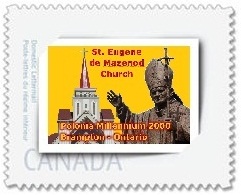
4th October 2020 @ 9:00 a.m. to 4:00 p.m. …
Mississauga’s 5th Annual Fall Show
25th October 2020; 29th November 2020

100. Rocznica założenia Klubu Sportowego Ruch Chorzów
100th Anniversary of the founding of the Ruch Chorzów Sports Club
www.poczta-polska.pl
Wartość: 3,30 zł … autorka projektu znaczka: Agnieszka Sancewicz;
autor koloryzacji fotografii: Mirosław Szponar; liczba znaczków: 1;
nakład: 90 000 szt.; technika druku: offset;
format znaczka: 40,5 x 40,5 mm; papier: fluorescencyjny;
arkusz sprzedażny: 5 znaczków i 1 przywieszka;
data wprowadzenia do obiegu: 20 kwietnia 2020 r.
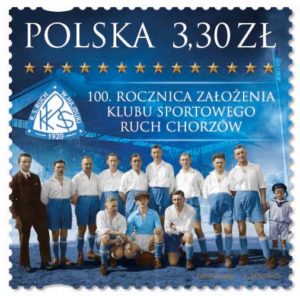
100th Anniversary of the founding of the Ruch Chorzów Sports Club …
denomination: 3,30 PLN; number of stamps in set: 1;
print run: 90.000 pcs; printing technique: offset;
stamp size: 40,5 x 40,5 mm; 5 stamps in sheet with label;
number of FDC: 1; photographic colouring : Mirosław Szponar;
author: Agnieszka Sancewicz; circulation date: 20th April 2020.
W dniu 20 kwietnia 2020 roku zostanie wprowadzony do obiegu znaczek pocztowy o wartości 3,30 zł emisji “100. rocznica założenia Klubu Sportowego Ruch Chorzów”. Na znaczku przedstawiono drużynę Klubu Sportowego Ruch Wielkie Hajduki (od 1939 roku Klub Sportowy Ruch Chorzów) z fotografii pochodzącej z początku lat 20. ubiegłego wieku; w centralnej części znaczka umieszczono pierwszy historyczny herb klubu oraz napis: 100. ROCZNICA ZAŁOŻENIA KLUBU SPORTOWEGO RUCH CHORZÓW, a nad nimi czternaście złotych gwiazdek, symbolizujących liczbę zdobytych tytułów ,,Mistrz Polski”; w tle widnieją trybuny stadionu K.S. Ruch Chorzów. Znaczki wydrukowano techniką offsetową, na papierze fluorescencyjnym, w formacie 40,5 x 40,5 mm, w nakładzie 90 000 sztuk. Arkusz sprzedażny zawiera 5 sztuk znaczków z przywieszką. Z tej okazji zostanie wydana koperta FDC. Autor koloryzacji fotografii: Mirosław Szponar, Autor projektu: Agnieszka Sancewicz.

100 lat Polskiego Towarzystwa Fizycznego
100 years of the Polish Physical Society
www.poczta-polska.pl
Dnia 24 kwietnia 2020 r. została wprowadzona do obiegu kartka pocztowa z nadrukowanym znakiem opłaty pocztowej, emisji: 100 lat Polskiego Towarzystwa Fizycznego. Wartość nominalna znaku opłaty pocztowej z oznaczeniem literowym A odpowiada wartości nominalnej znaczka pocztowego używanego do uiszczenia opłaty za ekonomiczną przesyłkę listową nierejestrowaną, w tym kartkę pocztową, w obrocie krajowym, w formacie S o masie do 500 g. W prawym górnym rogu strony adresowej kartki nadrukowano znak opłaty pocztowej, na którym przedstawiono fragment budynku, w którym aktualnie znajduje się siedziba Instytutu Fizyki Doświadczalnej Uniwersytetu Warszawskiego; wzdłuż dolnej krawędzi znaczka umieszczono napis: POLSKA oraz oznaczenie wartości: A. W części ilustracyjnej kartki umieszczono określenie przedziału czasowego ,,1920-2020″, logo Polskiego Towarzystwa Fizycznego, nazwę emisji ,,100 lat Polskiego Towarzystwa Fizycznego” oraz fotografie budynków, stanowiących siedzibę towarzystwa w latach 1920 oraz 2020. Kartki o wymiarach 148 x 105 mm wydrukowano jednostronnie, techniką offsetową, na kartonie białym, w nakładzie 8000 sztuk. Autor projektu kartki: Jarosław Ochendzan.
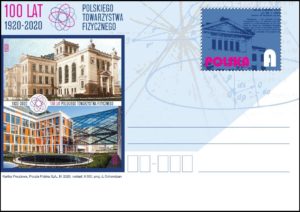
100 years of the Polish Physical Society … denomination: 3,30 PLN;
number of stationeries in set: 1; print run: 8.000 pcs;
printing technique: offset; card size: 148 x 105 mm;
author: Jarosław Ochendzan; release date: 24th April 2020.

Europa
Europe
www.poczta-polska.pl
W dniu 29 kwietnia 2020 został wprowadzony do obiegu znaczek pocztowy o wartości 5,00 zł emisji “Europa”. Na znaczku przedstawiono fragment schematycznie ujętej mapy Polski z zaznaczonymi głównymi szlakami pocztowymi funkcjonującymi w XVI w., wraz z naniesionymi na nich wizerunkami posłańców pieszych i konnych. W centralnej części znaczka umieszczono bieg rzeki Wisły wraz z usytuowanymi nad jej brzegami sylwetkami miast królewskich oraz nazwami miast: Kraków, Sandomierz, Warszawa, Toruń, Elbląg, Gdańsk. Wzdłuż górnej krawędzi umieszczono napis: Polska, oznaczenie wartości: 5 zł oraz logo: EUROPA, zaś wzdłuż dolnej krawędzi napis: DAWNE SZLAKI POCZTOWE. Znaczek wydrukowano techniką offsetową, na papierze fluorescencyjnym, format znaczka: 31,25 x 76,5 mm , format arkusika 121 x 221 mm, w nakładzie 120.000 szt. Arkusz sprzedażny zawiera 6 szt. znaczków. Z tej okazji została wydana również koperta FDC. Autor projektu znaczka: Maciej Jędrysik.
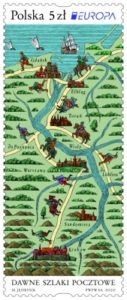
Europe … denomination: 5,00 PLN; print run: 120.000 pcs.;
printing techniques: offset; stamp size: 31,25 x 76,5 mm;
paper: fluorescent; sheet size: 121 x 221 mm;
6 stamps in sheet; number of FDC: 1;
author: Maciej Jędrysik; circulation date: 29th April 2020.

Dzień Pamięci o Majorze Hubalu
Major Hubal’s Memorial Day
www.poczta-polska.pl
Dnia 30 kwietnia 2020 r. została wprowadzona do obiegu kartka pocztowa z nadrukowanym znakiem opłaty pocztowej, emisji: Dzień Pamięci o Majorze Hubalu. Wartość nominalna znaku opłaty pocztowej z oznaczeniem literowym A odpowiada wartości nominalnej znaczka pocztowego używanego do uiszczenia opłaty za ekonomiczną przesyłkę listową nierejestrowaną, w tym kartkę pocztową, w obrocie krajowym, w formacie S o masie do 500 g. W prawym górnym rogu strony adresowej kartki nadrukowano znak opłaty pocztowej, na którym przedstawiono fotografię orderu Virtuti Militari, który należał do Henryka Dobrzańskiego ps. Hubal (1897-1940), majora kawalerii Wojska Polskiego; w części ilustracyjnej kartki znajduje się nazwa emisji ,,Dzień Pamięci o Majorze Hubalu” oraz napisy: Henryk Dobrzański (1897-1940) i HUBAL – z postacią Majora na koniu w tle. Kartki o wymiarach 148 x 105 mm wydrukowano jednostronnie, techniką offsetową, na kartonie białym, w nakładzie 8000 sztuk. Autor projektu kartki: Bożydar Grozdew.
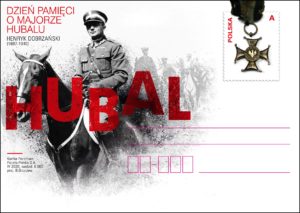
Major Hubal’s Memorial Day … denomination: 3,30 PLN;
number of stationeries in set: 1; print run: 8.000 pcs;
printing technique: offset; card size: 148 x 105 mm;
author: Bożydar Grozdew; release date: 30th April 2020.

Kwiaty i owoce
Flowers and fruits
www.poczta-polska.pl
W dniu 7 maja 2020 został wprowadzony do obiegu znaczek pocztowy o wartości 8,40 zł emisji “Kwiaty i owoce”. Znaczek wydrukowano techniką rotograwiurową , na papierze fluorescencyjnym, w formacie znaczka 31,25 x 25,5 mm , w nakładzie 5 milionów sztuk. Arkusz sprzedażny zawiera 100 znaczków. Z tej okazji została wydana również koperta FDC. Autor projektu: Marzanna Dąbrowska.
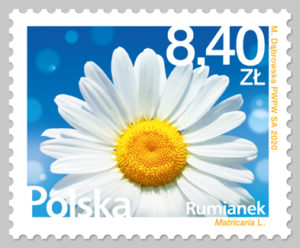
Flowers and fruits … denomination: 8,40 PLN;
number of stamps in set: 1; print run: 5 000 000;
printing techniques: photogravure; paper: fluorescent;
stamp size: 31,25 x 25,5 mm; 100 stamps in sheet;
number of FDC: 1; author: Marzanna Dąbrowska;
circulation date: 7th May 2020.

10. Rocznica tragedii smoleńskiej
www.nbp.pl
26 marca 2020 roku Narodowy Bank Polski wprowadził do obiegu srebrną monetę o nominale 10 zł oraz złotą o nominale 100 zł 10. rocznica tragedii smoleńskiej. Na każdej polskiej monecie kolekcjonerskiej znajdują się: nominał, wizerunek orła ustalony dla godła Rzeczypospolitej Polskiej, napis: Rzeczpospolita Polska, rok emisji. Awers monety złotej i srebrnej prezentuje fragment Katedry na Wawelu , napis „CORPORA DORMIVNT · VIGILANT ANIMAE” („CIAŁA ŚPIĄ · DUSZE CZUWAJĄ”), pochodzący z baldachimu nad wyjściem z grobów królewskich na Wawelu, w tle wizerunek Pałacu Prezydenckiego w Warszawie. Emisja wartości kolekcjonerskich stanowi okazję do upamiętniania ważnych historycznych rocznic i postaci oraz do rozwijania zainteresowań polską kulturą, nauką i tradycją.
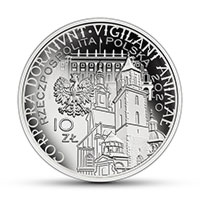
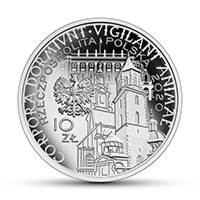
Nominał: 10 zł … Metal: Ag 925/1000; Stempel: lustrzany;
Średnica: 32,00 mm; Masa: 31,10 g; Brzeg (bok): gładki;
Nakład: do 14 000 szt. ; Projektant: Robert Kotowicz; Emitent: NBP;
Na zlecenie NBP monety wyprodukowała Mennica Polska S.A.
Na rewersie monety srebrnej widnieje personifikacja Polski – postać kobiety obejmującej odkształcony znak Sił Powietrznych RP, tworzący w centralnej części znak krzyża. U góry umieszczone zostały imiona i nazwiska osób, które zginęły w katastrofie samolotu w dniu 10 kwietnia 2010 r.
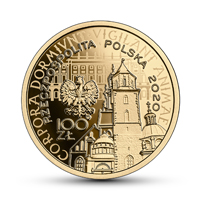
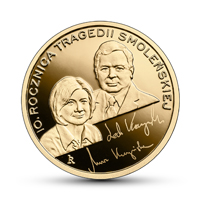
Nominał: 100 zł … Metal: Au 900/1000; Stempel: lustrzany;
Średnica: 21,00 mm; Masa: 8,00 g; Brzeg (bok): gładki;
Nakład: do 1500 szt.; Projektant: Robert Kotowicz; Emitent: NBP;
Na zlecenie NBP monety wyprodukowała Mennica Polska S.A.
Rewers monety złotej przedstawia wizerunek śp. pary prezydenckiej – Marii i Lecha Kaczyńskich oraz odwzorowanie ich podpisów.
Narody i państwa trwają i zasługują na miejsce w historii, o ile kultywują dobrą pamięć o swoich przodkach. Potrafią w imię głęboko rozumianych wartości prawdy i dobra złożyć hołd tym, którzy swoim życiem dowiedli miłości i oddania ojczyźnie. W imię tak pojmowanej pamięci 10 kwietnia 2010 roku udała się do Katynia delegacja przedstawicieli elity wolnej Polski na czele z prezydentem RP Lechem Kaczyńskim, pierwszą damą Marią Kaczyńską oraz ostatnim prezydentem RP na uchodźstwie Ryszardem Kaczorowskim. Mieli złożyć hołd ofiarom zbrodni katyńskiej, obywatelom II RP pomordowanym strzałem w tył głowy przez sowieckich żołnierzy w 1940 roku. W skład prezydenckiej delegacji weszli wicemarszałkowie Sejmu i Senatu, przedstawiciele parlamentu, dowódcy wszystkich rodzajów Sił Zbrojnych RP, pracownicy Kancelarii Prezydenta, szefowie instytucji państwowych, w tym prezes NBP Sławomir Skrzypek, przedstawiciele ministerstw, organizacji kombatanckich i społecznych, duchowni oraz osoby towarzyszące. O godzinie 8:41 czasu polskiego samolot prezydencki rozbił się w trakcie podchodzenia do lądowania na lotnisku w Smoleńsku.
Zginęło 96 osób. Do dziś nie mamy pełnych informacji o przyczynach tragedii. Wrak samolotu nie został wydany polskim śledczym przez rosyjskie władze. Nie jest możliwe przesłuchanie Rosjan z wieży kontroli lotów, a wszelkie próby dochodzenia prawdy są odrzucane przez rosyjskie propagandowe wersje tragedii. Na zawsze w naszej historii związały się ze sobą dwa wydarzenia: zbrodnia katyńska oraz tragiczna śmierć członków oficjalnej delegacji prezydenckiej pod Smoleńskiem, choć dzieli je 70 lat. W 10. rocznicę tragedii smoleńskiej oraz 80. rocznicę mordu katyńskiego warto przypomnieć słowa bp. Antoniego Pacyfika Dydycza wygłoszone w katedrze warszawskiej podczas homilii poświęconej ofiarom tragedii: „Pamięci nie da się zadusić. Nie udało się to w odniesieniu do męczenników Katynia, nie może się udać w odniesieniu do tych, którzy pielgrzymowali na miejsce zbrodni. I chociaż nie dotarli do samych grobów, to jednak swoim męczeństwem poniesionym w słusznej sprawie najpierw ukazali grozę tego, co się działo przed 70 laty, a następnie oddali życie swoje, pielgrzymując w poczuciu obowiązku, aby wstrząsnąć sumieniem całego świata”. Tak rozumiana pamięć jest jednym z fundamentów trwania narodu i państwa. Tak rozumiany obowiązek pielęgnowania pamięci jest dowodem suwerenności w myśleniu, która tworzy niepodległe państwo.
Tak rozumiał wagę i znaczenie pielęgnowania pamięci prezydent Lech Kaczyński. W niewygłoszonym przemówieniu miały paść słowa, które i dziś zachowały aktualność: „To wielka zasługa Rodzin Katyńskich. Ich walki o pamięć o swoich bliskich, a więc także – o pamięć i tożsamość Polski. Zasługa młodzieży. […] Zasługa tych nauczycieli, którzy – mimo zakazów – mówili dzieciom prawdę. Zasługa księży […]. Zasługa drukarzy nielegalnych wydawnictw. Zasługa wielu niezależnych inicjatyw i »Solidarności«. Milionów rodziców opowiadających swoim dzieciom prawdziwą historię Polski”. Naszym patriotycznym obowiązkiem jest zachowanie w osobistej oraz zbiorowej pamięci tych, którzy zginęli w Smoleńsku. Chcieli złożyć świadectwo prawdy o zbrodni katyńskiej. Tragedia ich śmierci to zobowiązanie dla nas, by godnie ich upamiętniać i wspominać. Przez mijające lata jednoczyliśmy się w modlitwie za ofiary tragedii w kolejnych dziesiątych dniach miesiąca, w kolejne rocznice. Ze smutkiem, ale i z szacunkiem wspominamy 96 osób, które godnie reprezentowały majestat Rzeczypospolitej. Informacja: Narodowy Bank Polski.

10th Anniversary of the Smolensk Tragedy
www.nbp.pl
On 26 March 2020, Narodowy Bank Polski issued into circulation a silver coin with a face value of 10 złoty and a gold coin with a face value of 100 złoty – “10th Anniversary of the Smolensk Tragedy”. All Polish collector coins feature: face value, image of the Eagle established as the state emblem of the Republic of Poland, inscription: Rzeczpospolita Polska, year of issue. Issuing collector items is an occasion to commemorate important historic figures and anniversaries, as well as to develop interest in Polish culture, science and tradition. The obverse of the gold and silver coins presents a fragment of Wawel Cathedral, an inscription “CORPORA DORMIVNT · VIGILANT ANIMAE” (THE BODIES ARE ASLEEP · THE SOULS ARE AWAKE) from the canopy over the exit from the Royal Tombs at Wawel, with the image of the Presidential Palace in Warsaw in the background.


Face value: 10 ZŁ … Metal: Ag 925/1000; Finish: proof;
Diameter: 32.00 mm; Weight: 31.10 g; Edge (side): plain;
Mintage: up to 14,000 pcs; Designer: Robert Kotowicz; Issuer: NBP;
The coins, commissioned by NBP, were struck by Mennica Polska S.A.
The reverse of the silver coin shows a personification of Poland, the figure of a woman, embracing a deformed marking of the Polish Air Force, which in its central part forms the sign of a cross. At the top are the names of the people who died in the plane crash on 10 April 2010.


Face value: 100 ZŁ … Metal: Au 900/1000; Finish: proof;
Diameter: 21.00 mm; Weight: 8.00 g; Edge (side): plain;
Mintage: up to 1,500 pcs; Designer: Robert Kotowicz; Issuer: NBP;
The coins, commissioned by NBP, were struck by Mennica Polska S.A.
The reverse of the gold coin depicts an image of the late presidential couple, Maria and Lech Kaczyński, and a reproduction of their signatures.
Nations and states endure and deserve a place in history as long as they preserve the memory of their ancestors and as long as they are able, in the name of deeply understood values of truth and goodness, to pay homage to those who proved their love and devotion to their homeland through their lives. In the name of such a memory, a delegation of representatives of the elite of a free Poland, headed by the President of the Republic of Poland, Lech Kaczyński, the First Lady, Maria Kaczyńska, and the last President of the Republic of Poland in exile, Ryszard Kaczorowski, went to Katyń on 10 April 2010. They intended to pay tribute to the victims of the Katyń massacre, citizens of the Second Republic of Poland murdered by a shot in the back of the head by Soviet soldiers in 1940. The presidential delegation included deputy Speakers of the Sejm and Senate, representatives of the Parliament, commanders of all branches of the Polish Armed Forces, employees of the Chancellery of the President, heads of state institutions, including NBP President Sławomir Skrzypek, representatives of ministries, of veterans’ and social organisations, as well as clergy and accompanying persons.
At 8:41 a.m. Polish time, the presidential plane crashed when attempting to land at the Smolensk airport. 96 people died. We do not yet have full information on the causes of the disaster. The plane wreck was not handed over to Polish investigators by the Russian authorities. It is not possible to interrogate the Russians from the control tower, and any attempts to reach the truth are thwarted by Russian propaganda versions of the tragedy. Although being 70 years apart, two events in our history are connected forever: the Katyń massacre and the tragic death of the members of the official presidential delegation near Smolensk. On the 10th Anniversary of the Smolensk tragedy and the 80th Anniversary of the Katyń massacre, it is worth recalling the words of Bishop Antoni Pacyfik Dydycz delivered in Warsaw Cathedral during his homily dedicated to the victims of the tragedy: “Memory cannot be suppressed. This has failed in relation to the martyrs of Katyń, and it cannot succeed in relation to those who made their pilgrimage to the site of the massacre. And despite not reaching the graves themselves, with their martyrdom in a just cause they first revealed the horror of what happened 70 years ago and then laid down their lives, making a pilgrimage with a sense of duty to shake the conscience of the whole world”. Memory understood in this way is one of the cornerstones of the nation’s and state’s existence. Such an understanding of the duty to cultivate memory is a proof of sovereign thinking, which creates an independent state.
This is how President Lech Kaczyński understood the importance of cultivating memory. The following words, which still remain valid today, were supposed to be spoken in the undelivered speech: “It is thanks to the Katyń Families. Their efforts to preserve the memory of their loved ones, and thus also the memory and identity of Poland. Thanks to the young. […] Thanks to those teachers who – despite the prohibitions – told children the truth. Thanks to the priests […]. Thanks to printers of underground publications. Thanks to many independent initiatives of the »Solidarity« movement. Millions of parents telling their children the true history of Poland”. Our patriotic duty is to preserve in our personal and collective memory those who died in Smolensk. They wanted to bear witness to the truth about the Katyń massacre. The tragedy of their death puts a responsibility on us to commemorate and remember them with dignity. Over the years we have been united in prayer for the victims of the tragedy on the consecutive tenth days of the month, on successive anniversaries. We remember with sadness, but also with respect, the 96 people who represented the majesty of the Republic of Poland with dignity. Info: Narodowy Bank Polski.


Group of Seven: PermanentTM Domestic stamps
www.canadapost.ca
Commemorate a century of Canadian artistic identity with this booklet of seven PermanentTM domestic rate stamps from our Group of Seven issue. Marking 100 years since the Group of Seven’s first show, this stamp series celebrates the indelible impact of these Canadian artists. The Group of Seven established a distinctively Canadian artistic style. Their paintings broke convention and forged a unique Canadian artistic identity – paving way for a century of Canadian artists to present their work on the world stage.
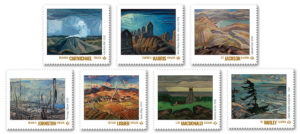
Stamp Value: PermanentTM (domestic rate) …
Quantity Produced: 180,000; Dimensions: 40 mm x 36 mm;
Stamp Designer: Lionel Gadoury, Matthew Killin,
Andrew Conlon | Context Creative;
Issue Date: May 7, 2020.
Group of Seven: Pane of 7 stamps … This colorful pane features seven PermanentTM domestic stamps from our Group of Seven issue. Marking 100 years since the Group of Seven’s first show, this stamp series celebrates the indelible impact of these Canadian artists. The Group of Seven established a distinctively Canadian artistic style with the way landscapes were painted and viewed. Quantity Produced: 35,000. Dimensions: 160 mm x 180 mm. Group of Seven: Set of 7 Official First Day Covers.
The First Day Covers … Add a touch of quintessential Canadian art to your collection with this set of seven Official First Day Covers commemorating the Group of Seven’s first exhibition. The set includes a unique cover and stamp for each founding member of the Group of Seven. Each cover is cancelled either in their place of birth or in a location that was relevant to their life in Canada. Marking 100 years since their first exhibit, the Group of Seven series celebrates the indelible impact of these Canadian artists. The Group of Seven established a distinctively Canadian artistic style with the way landscapes were painted and viewed. Quantity Produced: 7,000; Dimensions: 190 mm x 112 mm. Cancellation site: Orillia ON (Franklin Carmichael); Brantford ON (Lawren S. Harris); Montréal QC (A.Y. Jackson); Toronto ON (Frank H. Johnston); Halifax NS (Arthur Lismer); Toronto ON (J.E.H. MacDonald); Toronto ON (F.H. Varley).

From Far and Wide 2020: Postage-paid postcards
www.canadapost.ca
Some of Canada’s most iconic landscapes are captured in this set of nine postage-paid postcards from our From Far and Wide stamp series. Enjoy as part of your collection or send anywhere in the world. Each postcard features a photograph capturing a quintessentially Canadian location: French River, PE; Îles de la Madeleine, QC; Carcajou Falls, NT. Stamp Designer: Stéphane Huot. Issue Date: January 13, 2020.
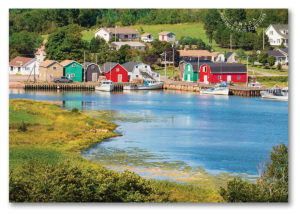
From Far and Wide 2020: Postage-paid postcard – French River (PE) … Send a bit of Prince Edward Island with this postage-paid postcard featuring the picturesque fishing village of French River. This postcard can be mailed from Canada to anywhere in the world. Part of the third From Far and Wide stamp issue honouring must-see Canadian destinations, this postcard features an enlarged image from one of the nine landscapes in this year’s issue. A quintessential picture of the timeless charm that brings countless visitors to Prince Edward Island every year, French River is a tiny fishing village on the north shore. Its fishing boats and brightly painted fishing sheds, framed by rolling farmland and woods, make the harbour one of P.E.I.’s most photographed and painted places.
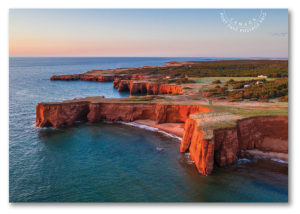
From Far and Wide 2020: Postage-paid postcard – Îles de la Madeleine (QC) … Send a view of one of Canada’s most scenic destinations with this postage-paid postcard featuring Quebec’s stunning Îles de la Madeleine. This postcard can be mailed from Canada to anywhere in the world. Part of the third From Far and Wide stamp issue honouring must-see Canadian destinations, this postcard features an enlarged image from one of the nine landscapes in this year’s issue. The Îles de la Madeleine are a small chain of islands in the Gulf of Saint Lawrence. Boasting a unique culture blended from its various settlers and inhabitants, including Acadian, French and Scottish, the islands attract visitors with renowned seafood cuisine, as well as endless beaches, marine excursions, and a thriving arts and culture scene.

From Far and Wide 2020: Postage-paid postcard – Carcajou Falls (NT) … Discover one of the North’s hidden natural wonders with this postage-paid postcard featuring the Northwest Territories’ Carcajou Falls. This postcard can be mailed from Canada to anywhere in the world. Part of the third From Far and Wide stamp issue honouring must-see Canadian destinations, this postcard features an enlarged image from one of the nine landscapes in this year’s issue. The rarely visited Carcajou Falls is located in the Mackenzie Mountains in the Sahtu region of the Northwest Territories. To see the falls – considered one of the most idyllic in the North – visitors must either make the arduous hike along the Canol Heritage Trail or take a flight tour. (Set of 9) … #2

2020 … Pure Silver Coin – Real Shapes: The Coat of Arms
www.mint.ca www.canadapost.ca www.canada.ca
A new take on a historic coin! Though it was among the first Canadian denominations struck at the new Ottawa branch of the Royal Mint in 1908, a 50-cent piece is a rare sight in everyday commercial transactions today. The Royal Canadian Mint continues to produce the 50-cent piece every year, but does not actively circulate it with other standard coins.
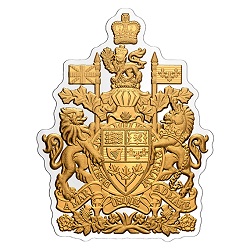
Face value: 50 dollars … Composition: 99.99% Pure Silver with
selective gold plating; Mintage: 1,200; Weight: 100 g;
Diameter: 50.7 x 66.7 mm; Finish: Proof; Edge: plain;
Certificate: serialized; Artist: Cathy Bursey-Sabourin (reverse);
Susanna Blunt (obverse).
Design: This coin has been specifically designed for consistent weight while also ensuring that the subject remains unaltered from the original in detail and proportions. From the 1994 50-cent coin reverse design, this rendering of the Canadian Coat of Arms includes a wide range of symbolic imagery. A lion holding a Union Jack flag on the left and a unicorn holding a flag bearing three French fleurs-de-lys on the right support a central shield divided into five sections bearing historical emblems of England, France, Scotland, and Ireland, as well as a sprig of three maple leaves. The shield is encircled with a ribbon representing the Order of Canada bearing the motto desiderantes meliorem patriam, which means “desiring a better country.” The shield is surmounted by a royal helmet within a garland of maple leaves, upon which stands a crowned lion holding a maple leaf. St. Edward’s Crown, symbolizing Canada’s constitutional monarchy, rests above the lion, which symbolizes Canada’s sovereignty. The motto a mari usque ad mari (“from sea to sea”) appears in a ribbon below the shield, along with a “compartment” or garland composed of the floral emblems of England, Scotland, France, and Ireland. The image is portrayed within its own silhouette. The obverse features the effigy of Her Majesty Queen Elizabeth II by Susanna Blunt.
Did you know… * Since 2004, the 50-cent piece has only been sold directly from the Royal Canadian Mint as a collector product. * One of the rarest and most collectible issues of the Canadian 50-cent piece is the 1921 issue—sometimes called the “King of Canadian Coins.” Throughout the 1920s, the Mint produced only a very small number of 50-cent pieces. In 1929, to meet demand, the Mint melted down excess stock from 1921 to make the new coins. Fewer than 100 of these are believed to have survived to the present day.

2020 … $3 Pure Silver Coin
– Floral Emblems of Canada – Ontario: White Trillium
www.mint.ca www.canadapost.ca www.ontario.ca
This $3 pure silver coin features Ontario’s trillium. Every Spring across the province, this pretty three-petaled flower’s blooms blanket the forest floor. The coin’s reverse proof finish gives it the look of vintage silver jewellery. This perfectly complements the colour portraits at the centre of our floral-themed celebration of Canada. Canada’s most populous province was one of the first to enter Confederation in 1867, and that’s why its floral emblem is the first one featured in our 13-coin series. Ontario officially adopted its floral emblem in 1937 with the passing of the Floral Emblem Act, and based on a recommendation made by a special committee of horticulturalists. Collect all of Canada’s provincial and territorial floral emblems with this 13-coin series! It’s the only series in 2020 to feature Canada’s unique flora at an affordable price. A new coin is issued monthly from March 2020 to March 2021.
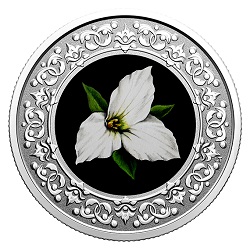
Face value: 3 dollars … Composition: 99.99% Pure Silver;
Mintage: 4,000; Weight: 7.96 g; Diameter: 27 mm;
Finish: Reverse Proof; Edge: serrated; Certificate: serialized;
Artist: Lisa Thomson-Khan (reverse); Susanna Blunt (obverse).
Tri means “three” in Latin and Greek, and it is the number of petals, sepals and leaves (bracts) that form each white trillium (Trillium grandiflorum). Ontario’s odourless provincial flower is a spectacular sight in late April through May, when it blooms en masse and blankets the forest floor. Canada’s most populous province was one of the first to enter Confederation in 1867, and that’s why its floral emblem is the first one featured in our 13-coin series. Ontario officially adopted its floral emblem in 1937 with the passing of the Floral Emblem Act, and based on a recommendation made by a special committee of horticulturalists.
Design: The reverse design by Canadian artist Lisa Thomson-Khan features a stylized floral pattern on the outer ring, while the inner core features a colour portrait of the official floral emblem of Ontario, the white trillium (Trillium grandiflorum). The obverse features the effigy of Her Majesty Queen Elizabeth II by Susanna Blunt. “I designed the series to evoke sentiments of antique hand-painted art, with vibrant colours and bold strokes that are reminiscent of a Victorian style. Inspired by the decorative filigree of fine silver, the ornate decorative border was purposely designed to complement the flowers, using stylized elements that move and twist across the surface like vines and leaves.” Lisa Thomson-Khan: Artist.
Did you know… * Outside of provincial parks and conservation areas, it’s not illegal to pick white trilliums in Ontario. But it’s not a good idea, either: you could seriously injure the plant and it can take years for it to produce another flower. * The spring-blooming trillium prefers well-drained soil and semi-shade growing conditions. In Ontario’s forests, you might spot it at the base of a beech or sugar maple tree. * A botanical work from 1760 referred to the trillium as “the herb True Love of Canada.” * Ants play a big role in dispersing trillium seeds. Half the seed is covered by an oily appendage known as elaiosome, which attracts hungry ants. They remove the seeds to carry them back to the nest, where they feast on the protein-rich elaiosome. The discarded seeds germinate in the tunnels and become a new plant. * In addition to the white trillium, four other trillium species are native to Ontario: red trillium, painted trillium, nodding trillium, and the endangered drooping trillium.

2020 … $3 Pure Silver Coloured Coin –
Blue Flag Iris: Floral Emblems of Canada: Quebec
www.mint.ca www.canadapost.ca www.quebec.ca
Celebrate spring flowers with this $3 pure silver coin featuring the iconic Blue Flag Iris. Part of the 13-coin Floral Emblems of Canada series, this vintage jewelry-inspired coin has a matte proof finish. It can be worn as a necklace using the 27mm bezel necklace kit (sold separately). While Iris versicolor can be found in marshes and along shorelines in central and eastern Canada, it has special meaning in the province of Quebec. This violet-blue wildflower is synonymous with wetlands, rivers and lakes in La belle province, where the provincial emblem blooms between late May and early July. Quebec was one of the first four Canadian provinces established by the British North America Act (Confederation) in 1867. And that’s why its provincial flower is our second coin in our vintage jewellery-inspired Floral Emblems of Canada series. And, your coin’s reverse features a colourful depiction of the blue flag iris, which gained official status as the floral emblem of Quebec in 1999.
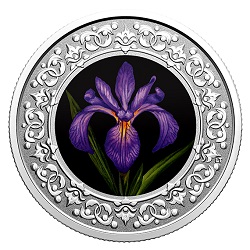
Face value: 3 dollars … Composition: 99.99% Pure Silver;
Mintage: 4,000; Weight: 7.96 g; Diameter: 27 mm;
Finish: Reverse Proof; Edge: serrated; Certificate: serialized;
Artist: Lisa Thomson-Khan (reverse); Susanna Blunt (obverse).
Design: The reverse design by Canadian artist Lisa Thomson-Khan features a stylized floral pattern on the outer ring, while the inner core features a colour portrait of the official floral emblem of Quebec, the blue flag iris (Iris versicolor). The obverse features the effigy of Her Majesty Queen Elizabeth II by Susanna Blunt.
Did you know… * Between 1963 and 1999, the province’s floral emblem was the Madonna lily (Lilium candidum), which resembles the fleur-de-lis on the provincial flag. But the fact that the plant species isn’t indigenous to Quebec sparked a movement to adopt a new floral emblem, which the province did on November 5, 1999. * Its botanical name, versicolor, means “changeable in colour” and that’s a fitting descriptor for the blue flag iris, which comes in various shades of blue or purple with yellow and white markings. Other common names include blue wild iris, water flag and American fleur-de-lis. * The blue flag iris is a favourite of hummingbirds, bees, and butterflies.

2020 … $3 Pure Silver Coloured Coin –
Mayflower: Floral Emblems of Canada: Nova Scotia
www.mint.ca www.canadapost.ca www.gov.ns.ca
The sweet scent of the mayflower is the fragrance of spring in Nova Scotia! This creeping wildflower blooms in April and May, when crowded clusters of tiny pink and white flowers appear on leathery leaves in forest glades. Trailing arbutus, better known as the mayflower, has been Nova Scotia’s official flower since 1901. And it is in full bloom on coin #3 in our jewellery-inspired series, which highlights the floral emblems of every Canadian province and territory.
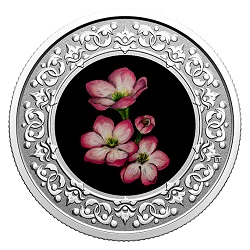
Face value: 3 dollars … Composition: 99.99% Pure Silver;
Mintage: 4,000; Weight: 7.96 g; Diameter: 27 mm;
Finish: Reverse Proof; Edge: serrated; Certificate: serialized;
Artist: Lisa Thomson-Khan (reverse); Susanna Blunt (obverse).
Design: The reverse design by Canadian artist Lisa Thomson-Khan features a stylized floral pattern on the outer ring, while the inner core features a colour portrait of the official floral emblem of Nova Scotia, the trailing arbutus or mayflower (Epigaea repens). The obverse features the effigy of Her Majesty Queen Elizabeth II by Susanna Blunt.
Did you know… *The mayflower appeared on 19th century militia buttons, stamps and even a pre-Confederation coin issued by Nova Scotia. In 1901, an act of the Nova Scotia legislature stated the mayflower “is hereby declared to be and from time immemorial to have been the emblem of Nova Scotia.” *The creeping mayflower is a shrub, even if it doesn’t look like it. Technically, it is “subshrub” (a dwarf shrub with a woody base) and it grows very close to the ground – in fact, its scientific name Epigaea repens means “creeping on the earth.” * It is naturally occurring in eastern North America, from Newfoundland and Labrador to Manitoba, and all the way south to Florida (United States). But the mayflower doesn’t take well to being transplanted and it has very specific growing conditions, so it’s best to just admire it in the wild.

2020 … $5 Pure Silver Coin – Moments to Hold:
Celebrating 100 years of the RCMP
as Canada’s national police force
www.canadapost.ca www.mint.ca
In 2020, it will mark 100 years from when the Royal North West Mounted Police and the Dominion Police combined to become Canada’s national police service. The Royal Canadian Mounted Police (RCMP) has evolved into a modern organization. But even today, the red-coated Mountie on horseback is one of the most famous faces of Canada in the eyes of the world. You get ¼ oz. of 99.99% pure silver for $24.95, struck from some of the purest silver in the world. With meaningful themes that enrich our knowledge and appreciation of our country, this four-coin series marks important subjects that are the fabric of Canada. Coin #1 is a tribute to the Royal Canadian Mounted Police, which became Canada’s national police force 100 years ago. The curve text (“CANADA”) and the date (“2020”) are the unifying features of this series – you’ll find them on all four coins in this series. Your coin comes in a full-colour custom folder. The bespoke capsule for each coin allows you to pop it out of the packaging, to get a close up view of the coin.
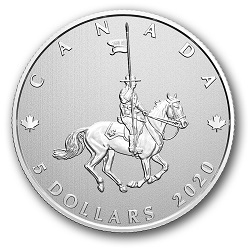
Face value: 5 dollars … Composition: 99.99% Pure Silver;
Mintage: 100,000; Finish: specimen; Weight: 7.96 g;
Edge: serrated; Certificate: serialized; Diameter: 27 mm;
Artist: Ago Aarand (reverse), Susanna Blunt (obverse).
Design: The engraved image features a member of the Royal Canadian Mounted Police on horseback. The reverse also includes the word “CANADA” near the curved rim and flanked by maple leaves, while the face value “5 DOLLARS” and the year “2020” are inscribed below. The obverse features the effigy of Her Majesty Queen Elizabeth II by Susanna Blunt. “This coin kicks off a great new series that focuses on big Canadian moments, and it begins with a celebration of the RCMP – a truly Canadian icon! This is a must-have series for your collection.” Erica Maga, Product Manager, Royal Canadian Mint. “As an artist, I love re-constructing and adapting classic designs to bring them into the present. The original sculpted model was slightly outdated so instead of re-creating it, I enhanced its elements. Notice how the horse anatomy is more prominent; the staff is also straighter, the hands and gloves are more accurate, the reins are more detailed and the officer’s facial features are sharper.” Alex Tirabasso, Engraver/3D Artist, Royal Canadian Mint.
Did you know… *The Stetson hat is a famous element of the RCMP uniform, and they’re all crafted in Guelph, Ontario. How can you tell if it’s a real RCMP hat? Look inside – it should include a stamped “RCMP-GRC” and a contract date as proof of authenticity. *The RCMP Musical Ride is a full troop of 32 uniformed riders (as well as the member in charge) that famously performs choreographed cavalry drills to music. Its origins can be traced back to the early days of the North West Mounted Police, when members would entertain themselves in-between drills by competing and performing tricks. *In 1919, legislation was passed to merge the Dominion Police (a small federal force created in 1868) and the Royal North West Mounted Police (a frontier force created in 1873). On February 1, 1920, Canada’s newly merged police force was named the Royal Canadian Mounted Police.

2020 … Pure Silver Coloured Coin
– 75th Anniversary of the Liberation of the Netherlands:
Canadian Army
www.mint.ca www.canadapost.ca
A life saved is a bond forged. This selectively coloured coin shows the Liberation of the Netherlands from the perspective of those who lived it. Beneath the repeating “V” (for Victory) in Morse code, its depiction of a gift of tulips serves as a tribute to the people of the Netherlands and to the First Canadian Army, which was cast in the role of liberator in 1945.
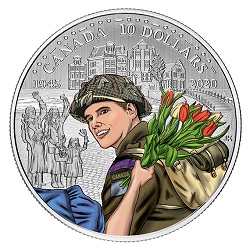
Face value: 10 dollars … Composition: 99.99% Pure Silver;
Mintage: 100,000; Weight: 15.87 g; Diameter: 34 mm;
Finish: Specimen; Edge: Serrated;
Artist: Joel Kimmel (reverse), Susanna Blunt (obverse).
Design: Designed by Joel Kimmel, the reverse uses selective colour to highlight a warm exchange between a soldier of the First Canadian Army and a Dutch civilian during the Liberation of the Netherlands (1945). The woman offers a gift of tulips to the Canadian infantry soldier, who is happy to see a friendly face. In the engraved background, a small crowd has gathered to cheer and wave at the Canadians as they travel along a canal street. The top features a repeating “V” for Victory in Morse code above the words “CANADA 10 DOLLARS”. The obverse features the effigy of King George VI by T. H. Paget and a Victory privy mark.
Did you know… * About 2,000 Dutch war brides married Canadian servicemen and immigrated to Canada after the war. Today, roughly 3% of Canadians (over one million) are of Dutch descent. * The tulips that bloom in Ottawa are the most visible symbols of the historic relationship between Canada and the Netherlands. The tradition began after the war, when then-Crown Princess Juliana gifted thousands of tulip bulbs in recognition of Canada’s hospitality and assistance throughout the war. * On January 19, 1943, Her Royal Highness Princess Margriet became the only royal ever born in Canada… well, not “in” Canada. To ensure the newborn royal would have Dutch citizenship and a place in the line of succession, Canada temporarily disclaimed the four-room suite at the Ottawa Civic Hospital by declaring it extraterritorial (unaffiliated international territory). * Canadian Mona Louise Parsons (1901-1976) was a member of the Dutch resistance. She was born in Nova Scotia and settled in the Netherlands in 1937 after marrying a Dutch businessman. She was arrested in 1941 for helping downed Allied airmen evade capture. When the prison was bombed in 1945, Parsons managed to walk across Germany and cross into the Netherlands. For her incredible courage, Parsons received commendations from General Eisenhower and Air Chief Marshall Tedder of the Royal Air Force.


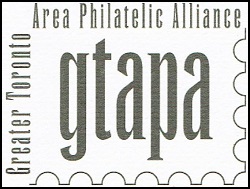
www.gtapa.org
The GTAPA is committed to promote
and stimulate the art of philately
to all ages for fun, culture, education and friendship.

